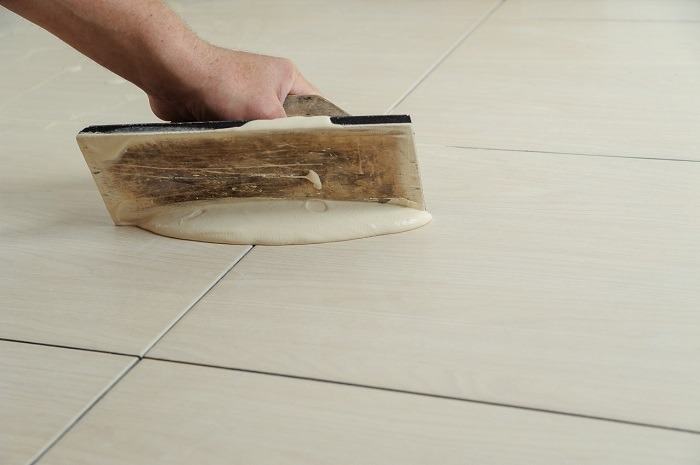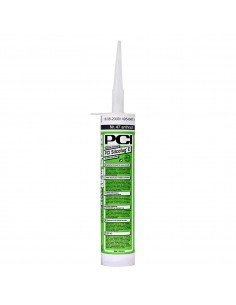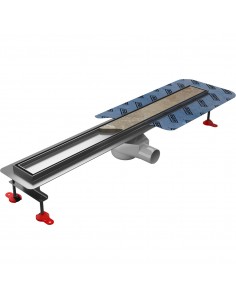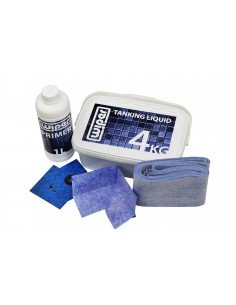- Alex D.
- Shower drains
- 8856 views

A great important finishing material is grout for floor and wall tiles. It is worth choosing it according to the specificity of tiles and the type of room. Cement grout is the most popular, but for some time now more and more interest has been focused on the epoxy grout due to its durability.
Table of content
- Grout types
- What is an epoxy grout
- Where to use epoxy grout
- Right Grout for Various Surfaces
- Cement Grout vs. Epoxy Grout
- Epoxy grout Installation
- Epoxy Grout Colors and Sealing Options
- Grout alternatives
- Summary
The most widespread types of grout
- Cement grout
- Elastic cement grout
- Acrylic grout
- Silicon grout
- Epoxy grout
What is an epoxy grout?
Also known as resin grout, it is a unique mixture of epoxy resin and hardener. In some productions, a special ingredient in the form of quartz sand is also used. It is one of the varieties of epoxy glues, so tile joints are more durable and stronger than traditional cement grout. Its application is wide. It is intended for both indoor and outdoor areas. It is characterised by above-standard hardness and resistance to mechanical damage. It is not susceptible to acids, chemicals and variable temperatures. Another important property is resistance to mold and prolonged contact with water.
Where to use epoxy grout?
The epoxy grout is smooth and non-absorbent. As a result, more often, in addition to specialist rooms such as laboratories, sanitary nodes, swimming pools or restaurant kitchens, epoxy grouts are also used in single-family homes. They are successfully used in wet rooms, bathrooms, toilets. They also work well in all other rooms where they are exposed to prolonged contact with water and moisture, i.e. garage, veranda, winter garden or boiler room.
They can not be used on balconies and terraces, because they have a barrier of permeability, thus blocking the possibility of draining and evaporating the moisture accumulated under the tiles, which in consequence would lead to chafing and falling off of tiles on the floor after the winter.
They are suitable for grouting ceramic and stone tiles. They are recommended for large tiles, where a 1–1.5 mm thick joint is usually used. Thicker joints are not recommended.
Choosing the Right Grout for Various Surfaces
Whether you’re working with marble, glass, or standard ceramic tiles, the selection of grout can make or break your final appearance. Epoxy grouts are often the go-to choice in bathroom installations, swimming pools, or other high-humidity environments because of their non porous nature. Meanwhile, cement variants might be preferable in spaces like balconies or terraces—just be cautious of moisture accumulation underneath the tile.
- Marble Surfaces - Marble can be prone to discoloration if the grout is too alkaline or if it penetrates the stone. Choosing an epoxy resin based product can help form a protective barrier.
- Glass Tiles - Because they reflect light, you’ll want an adhesive and grout color that won’t show through the tile. Consider a colour that matches or accentuates the glass, and remember that epoxy often bonds more effectively than ordinary mortar when dealing with slick backings.
- Porcelain or Ceramic Tile - Standard ceramic tile often pairs well with cement grouts for cost efficiency. However, if you expect foot traffic or a need for superior staining protection, epoxy tile grout may be the better pick.
Cement Grout vs. Epoxy Grout
If you already know the basics of cement grout, you might be wondering how it truly stacks up against epoxy grout in real-world applications. Traditional cement based grout has been a staple in the construction industry for many years, mainly because it’s budget-friendly and easy to work with. However, its porous nature can mean moisture penetration, which may lead to staining or cracking under certain conditions. On the other hand, epoxy tile grout stands out for its non porous nature, offering highly resistant performance against dirt and moisture. Thanks to the two component blend of resin and hardener, it forms a robust seal around ceramic tile or other tiles—often an incredibly helpful advantage in heavy traffic areas.
When comparing the two, keep these points in mind:
- Chemical Resistance: Epoxy has high chemical resistance, making it suitable for areas exposed to harsh cleaning agents.
- Cost and Skill: Cement-based grouts are simpler to apply, while using epoxy grout can be more labor-intensive and sometimes requires a bit of practice or professional advice.
- Longevity: Epoxy-based grouting typically outlasts the cement type, offering a great finish and very little staining over time.
If you’re not sure how much grout you need—or which type best suits your floors, walls, or other surfaces—it’s wise to consult with tilers or check our Shop section for more detailed specs.
Cement-Based Alternatives in Your Product Line
While epoxy remains a premium choice for non porous sealing, certain projects simply don’t require that level of chemical resistance or water-tightness. In such cases, you can opt for high-performance cement-based or polymer-enhanced products, like:
- PCI Nanofug® Premium: A flexible cement grout that delivers excellent crack resistance and long-term durability. Suitable for both walls and floors where standard epoxy might be excessive.
- PCI Silcofug® E: A silicone sealant that complements either epoxy or cement-based grouting—perfect for perimeter joints, corners, or transitions between tile and other surfaces like acrylic tubs or glass panels.
Choosing these options can be especially useful on balconies, terraces, or in heavy traffic areas where foot traffic is continuous but full chemical impermeability is not mandatory.
Installation of epoxy grout
Its application differs from the assembly of cement grout. To properly apply it, follow the requirements given by the manufacturer. Special tools are used, i.e. a properly selected and durable float and hard sponges, e.g. from non-woven fabric to grout and cellulose sponges for profiling. For difficult places to fill, a special silicone scraper is used.
After proper preparation of the grout, the application must be carried out within a short time, because after about 30 minutes the grout is permanently bonded. It is not an easy task, therefore professionals are not always happy to decide on its assembly. I recommend that you prepare a small amount at the beginning so that you do not waste unused material in case of a longer application. After finishing grouting, the product needs about 2 weeks to allow the joints to be fully durable.
In theory, we consider joints between tiles as a less important finishing element. We focus our attention mainly on choosing the right tiles. Let us remember that grouting must withstand for many years in the best visual condition and be resistant to all external factors that threaten its durableness. It's worth taking the time to adjust the grout to the type of tiles and the room, so that after a while they do not scare away, and at the same time protect our surfaces for many years. There are many products on the market with high strength parameters. However, to extend the durability of the grout, proper care is also necessary.
Essential Tools and Components for a Great Finish
Before you begin tiling with epoxy, gather all your necessary items:
- Grout Float – Helps press the mixture firmly into grout lines and joints.
- Bucket – You’ll need one or two for mixing components and another with clean water for rinsing.
- Sponge – A durable, high-quality sponge is essential for wiping away any excess grout or residue.
- Hardener and Resin – Since epoxy is a two component system, make sure to measure carefully to maintain the proper ratio.
- Silica Sand (if needed) – Some epoxy formulations incorporate silica sand for improved texture or fill.
Using these tools correctly can drastically simplify your process and deliver a great finish. If you’d like further advice on selecting the right kit, check our Construction Chemicals section in our Shop – our company offers a variety of specialized gear.
Epoxy Grout Colors and Sealing Options
One of the good reasons many tilers choose epoxy is the broad range of grout colors. Modern options include neutral whites, bold blacks, and every shade in between. By selecting the right tone, you can highlight or blend your tiles for a sophisticated result.
- High Chemical Resistance: Because epoxy is inherently tough, it maintains its colour and gloss even in heavy traffic areas or industrial settings.
- Sealing: While standard cement solutions may require routine sealing to prevent staining, epoxy rarely does. This means fewer steps in your overall process, saving both time and money.
Grout alternatives
In some projects, you may need more than just the grout itself. For instance, if you’re working in a damp environment but don’t necessarily require a full epoxy solution, you can:
- Pre-treat floors or walls with PCI Seccoral 2K Rapid: A robust waterproofing slurry that ensures no moisture seeps into the substrate, helping preserve both cement and epoxy-based grouts.
- Use PCI Nanolight as a flexible adhesive to bond tiles securely, allowing for minor substrate movements without cracking the tile or joints.
These steps create a strong base and improve long-term durability, especially in bathrooms or other wet areas where standard adhesives might fall short.
Final Thoughts and Product Recommendations
Before jumping into any grouting job, especially with epoxy, it’s essential to gather the right materials and understand the process. The two component formulation—consisting of resin and a hardener—offers highly resistant sealing, minimal staining, and robust performance even under foot traffic. For ceramic tile installations in heavy traffic areas, epoxy tile grout can outlast cement variants by a wide margin, making it a good reason to invest in a product with long-term benefits.
At our company, we stock numerous grouts designed for a variety of tiles and surfaces. If you have any questions or need a bit more advice, feel free to contact us. Our team can guide you on using grout, selecting the best colour for your tile surface, and ensuring your next tiling project has the great finish you’ve always wanted.
Looking for top-tier adhesives and sealants?
- PCI Nanofug® Premium for a high-performance cement grout.
- PCI Nanolight® for flexible tile installation in challenging conditions.
- PCI Silcofug® E for sealing edges, corners, or expansion joints.
- PCI Seccoral® 2K Rapid for waterproofing before grout application in damp or heavy-use areas.
Investing in the right adhesive and grout combination ensures your tiling job remains beautiful and functional for years to come.









